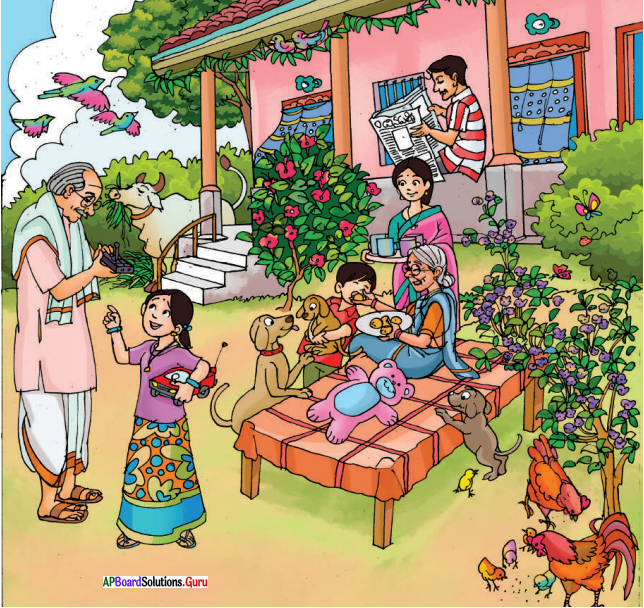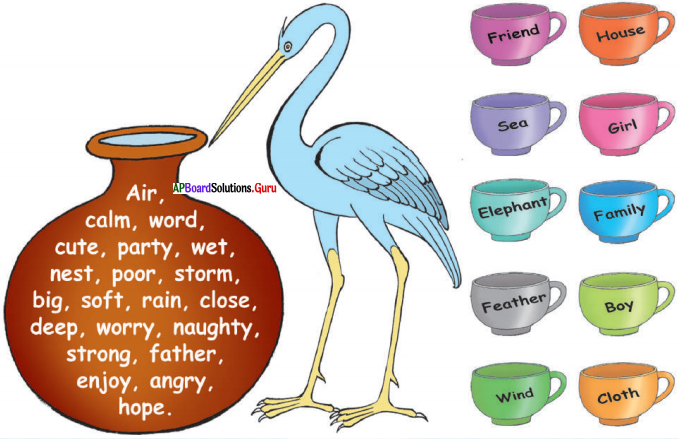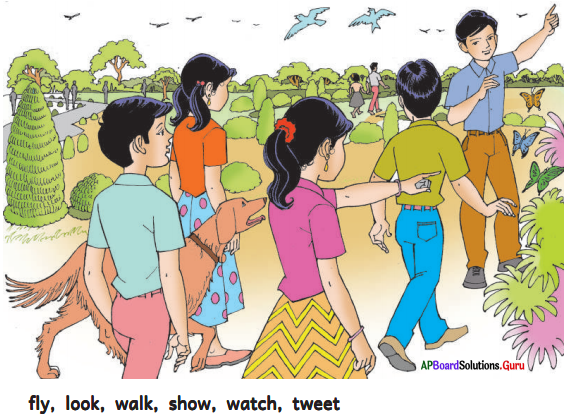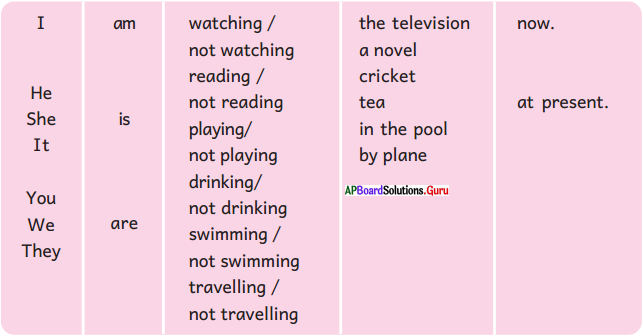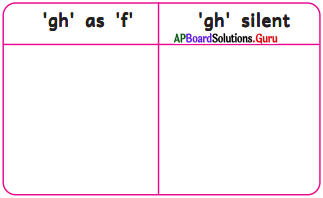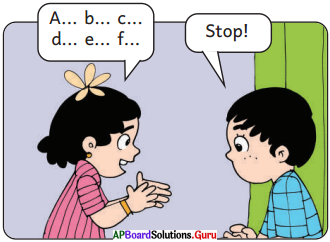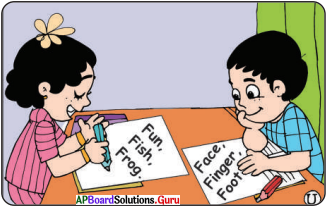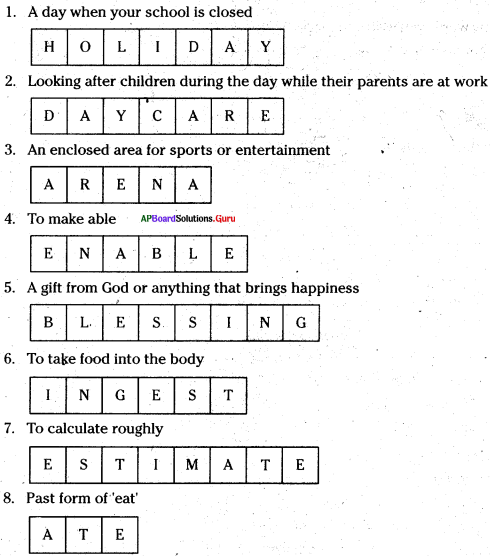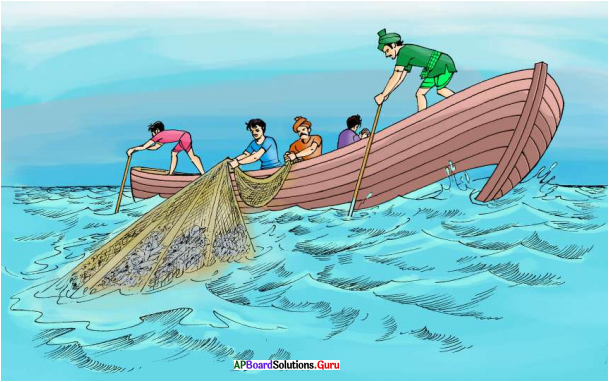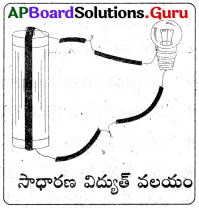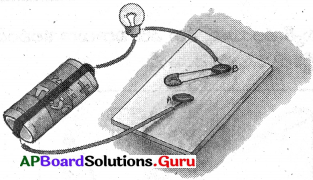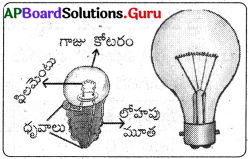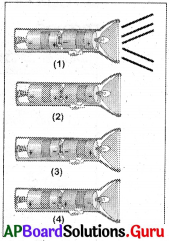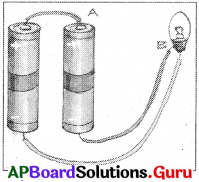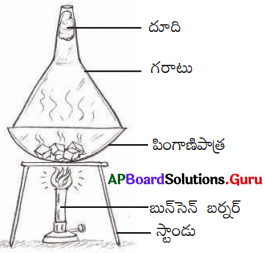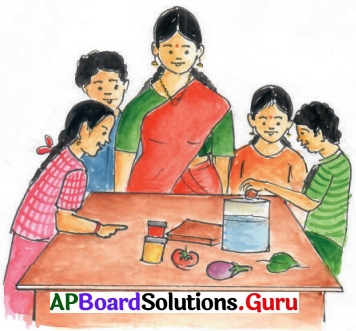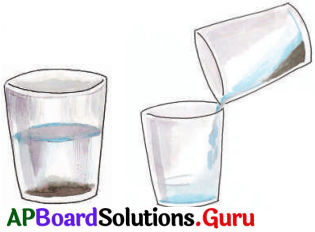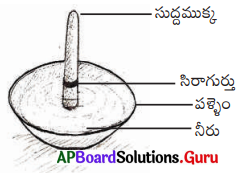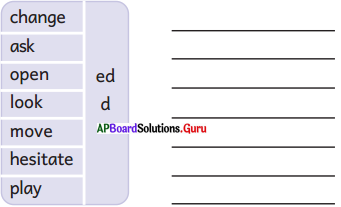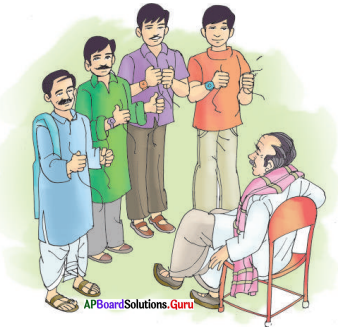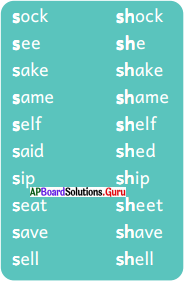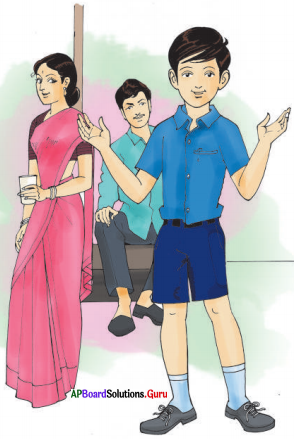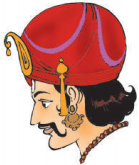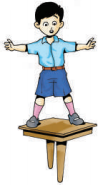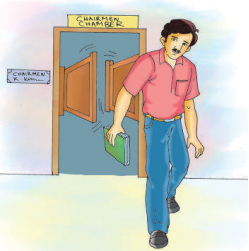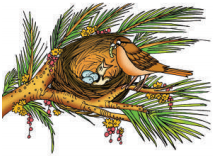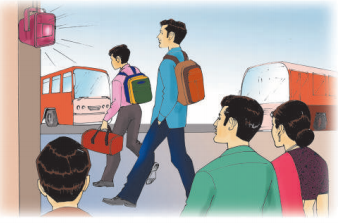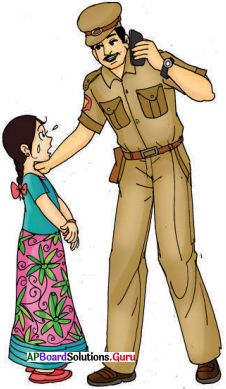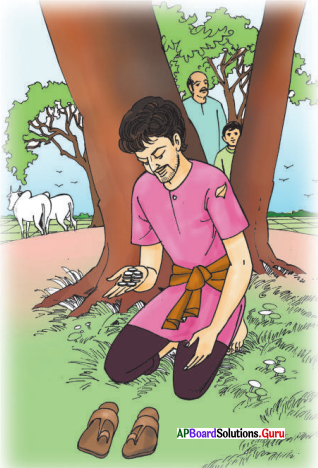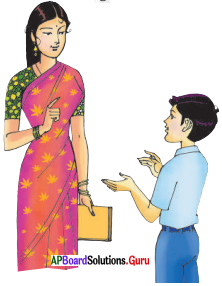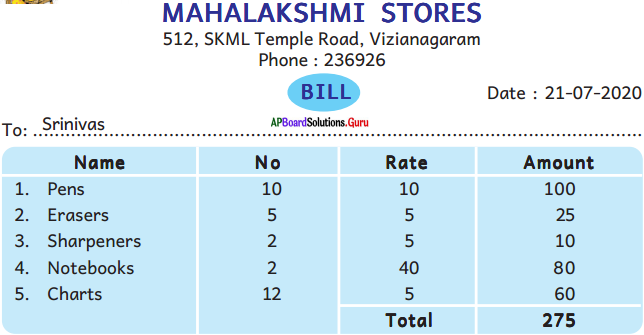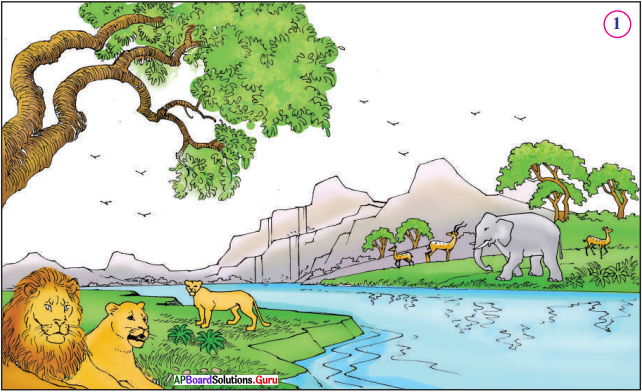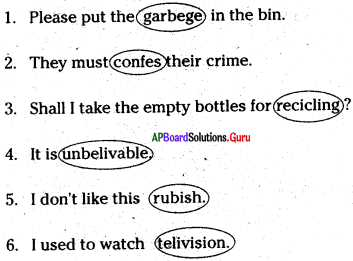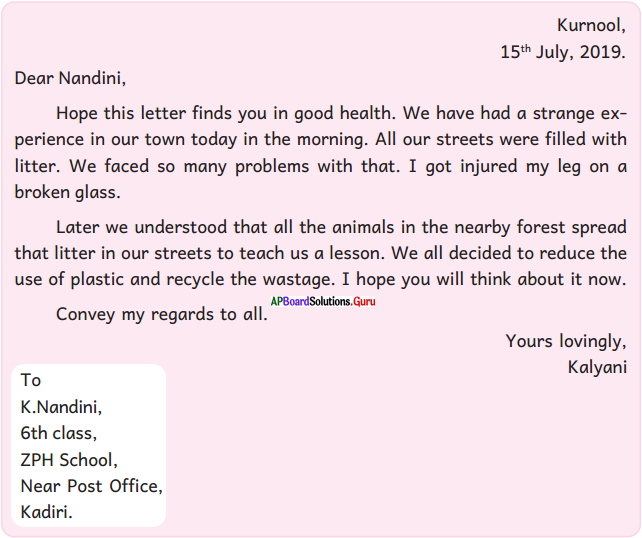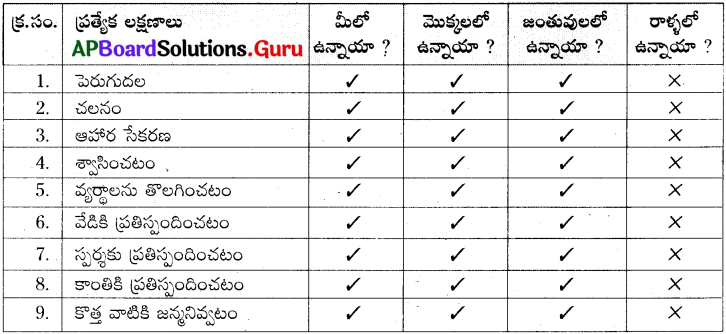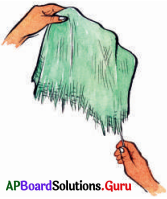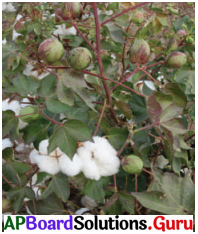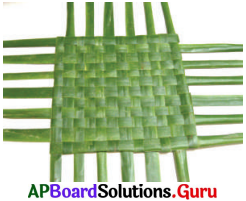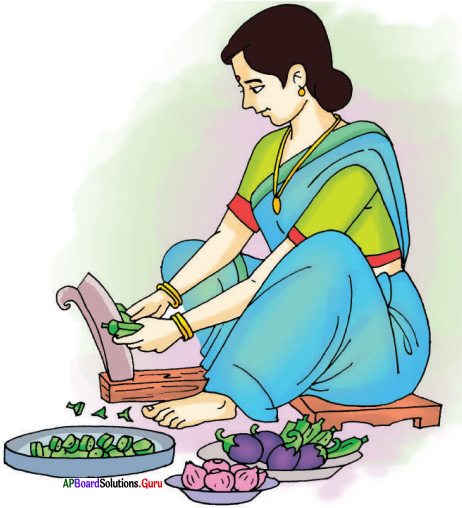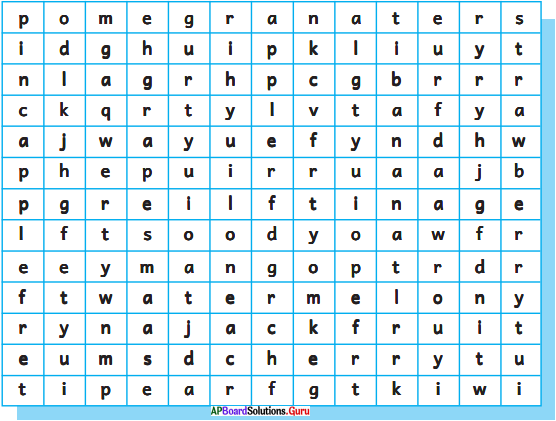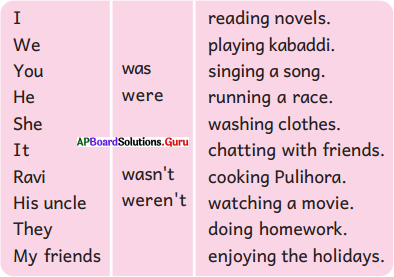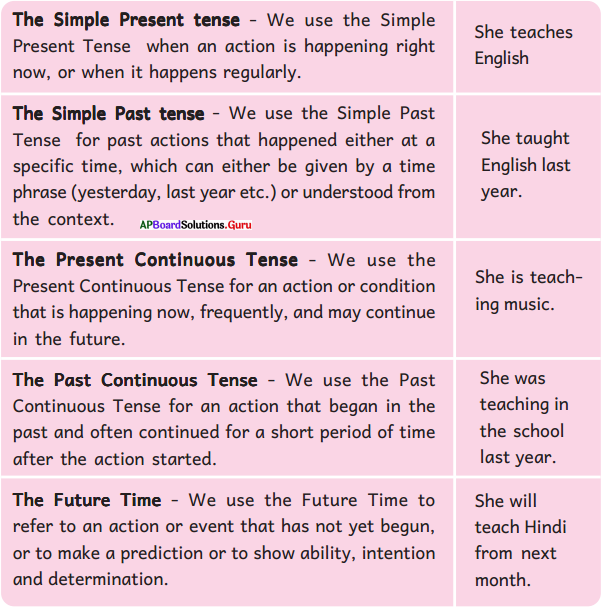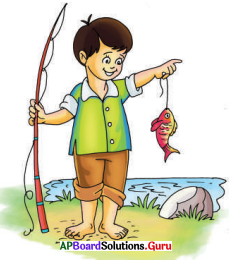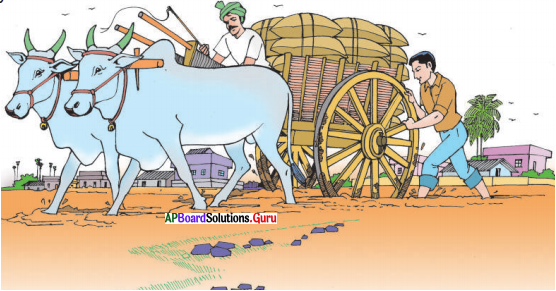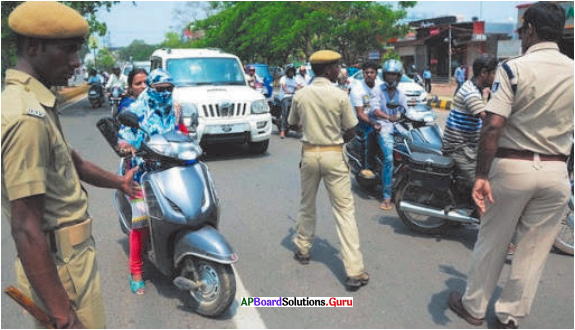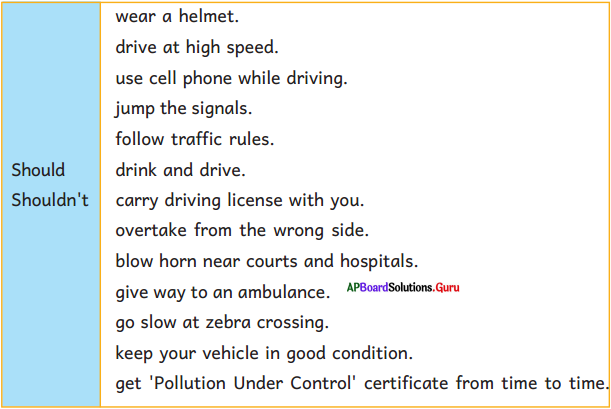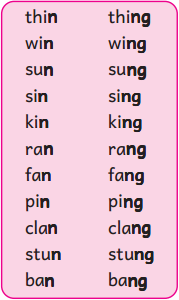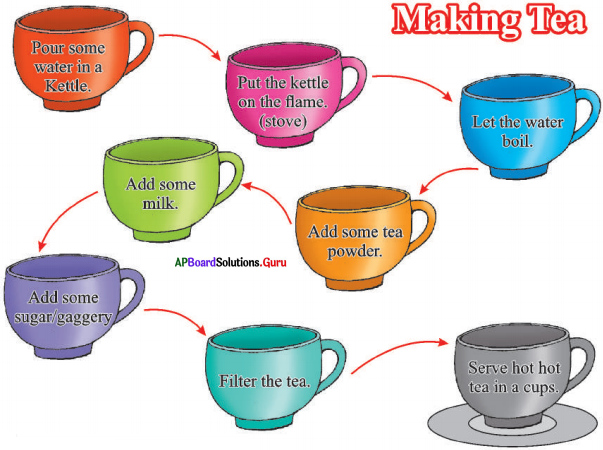SCERT AP 6th Class Science Study Material Pdf 11th Lesson నీడలు – ప్రతిబింబాలు Textbook Questions and Answers.
AP State Syllabus 6th Class Science 11th Lesson Questions and Answers నీడలు – ప్రతిబింబాలు
6th Class Science 11th Lesson నీడలు – ప్రతిబింబాలు Textbook Questions and Answers
Improve Your Learning (అభ్యసనాన్ని మెరుగుపరచుకుందాం)
I. ఖాళీలను పూరించండి.
1. కాంతి ……………….లో ప్రయాణిస్తుంది. (ఋజు మార్గం)
2. కాంతిని ఇచ్చే పదార్థాన్ని ……………… అంటారు. (కాంతి జనకం)
3. ఒక వస్తువును తాకిన తర్వాత వెలుతురు తిరిగి వెనక్కు మరలటాన్ని …………… అంటారు. (పరావర్తనం)
4. ఆకుపచ్చ చెట్టు ద్వారా ఏర్పడిన నీడ యొక్క రంగు ……………. (నలుపు)
II. సరైన సమాధానాన్ని గుర్తించండి.
1. పారదర్శక పదార్థాన్ని గుర్తించండి.
A) కాగితం
B) చెక్క
C) గాజు
D) నూనె కాగితం
జవాబు:
C) గాజు
2. నీడను ఏర్పరచే పదార్థం
A) పారదర్శక పదార్థం
B) పాక్షిక పారదర్శక పదార్థం
C) కాంతి నిరోధక పదార్థం
D) పైవన్నీ
జవాబు:
C) కాంతి నిరోధక పదార్థం
![]()
3. నీడ ఏర్పడటానికి కావలసినవి
A) కాంతి వనరు
B) కాంతి నిరోధక పదార్థం
C) తెర
D) పైవన్నీ
జవాబు:
D) పైవన్నీ
III. ఈ క్రింది ప్రశ్నలకు జవాబులు రాయండి.
ప్రశ్న 1.
కింది ఇచ్చిన వస్తువులను పారదర్శక, అపారదర్శక, పాక్షిక పారదర్శక పదార్థాలుగా వర్గీకరించండి.
కార్డ్ బోర్డ్, డస్టర్, పాలిథీన్ కవర్, నూనె కాగితం, గాజుపలక, కళ్ల అద్దాలు, చాక్బస్, బంతి, బల్ల, పుస్తకం, కిటికీ అద్దం, అరచేయి, మీ పుస్తకాల సంచి, అద్దం, గాలి, నీరు. మీ పరిసరాలలో ఏ పదార్థాలు ఎక్కువగా ఉన్నాయి?
జవాబు:
ఎ) పారదర్శక పదార్థాలు :
గాజు పలక, కిటికీ అద్దం, కళ్ల అద్దాలు, గాలి, నీరు
బి) అపారదర్శక పదార్థాలు :
కార్డ్ బోర్డ్, డస్టర్, చాక్ పీస్, బంతి, బల్ల, పుస్తకం, అరచేయి, పుస్తకాల సంచి, అద్దం
సి) పాక్షిక పారదర్శక పదార్థాలు :
పాలిథీన్ కవర్, నూనె కాగితం
ప్రశ్న 2.
“పూర్తిగా పారదర్శకమైన పదార్థాలను మనం కాంతి సమక్షంలోనూ చూడలేము.” ఇది సరియైనదా? కాదా? మీ సమాధానాన్ని సమర్థించండి.
జవాబు:
అవును, పూర్తిగా పారదర్శక వస్తువుల ఉనికిని కాంతిలో మనం గుర్తించలేము. ఎందుకంటే ఇవి కాంతిని తన గుండా వెళ్ళడానికి అనుమతిస్తాయి. కాబట్టి మనం వాటిని కనుగొనలేము.
ఉదా : గాలి, గాజుపలక.
ప్రశ్న 3.
మన వెనుక ఉన్న వస్తువులను మనం ఎందుకు చూడలేం?
జవాబు:
కాంతి ఋజుమార్గంలో ప్రయాణిస్తుంది కావున, మన వెనుక ఉన్న వస్తువుల నుండి ప్రతిబింబించే కాంతి మన కళ్ళకు చేరలేదు. కాబట్టి మన వెనుక ఉన్న వస్తువులను మనం చూడలేము.
ప్రశ్న 4.
ఒక అపారదర్శక వస్తువుకు నీడ ఏర్పడాలంటే ఏమేమి కావాలి?
జవాబు:
అపారదర్శక వస్తువు నీడను ఏర్పరచాలంటే
- కాంతి జనకం
- అపారదర్శక వస్తువు
- తెర కావాలి.
![]()
ప్రశ్న 5.
సమతల దర్పణాన్ని కుంభాకార దర్పణంగా ఉపయోగించవచ్చా? కాకపోతే ఎందుకు?
జవాబు:
లేదు, మనం సమతల దర్పణాన్ని వెనుక వాహనాలను చూడటానికి ఉపయోగించలేము. ఎందుకంటే సాదా అద్దం వాహనం వెనుక ఉన్న అన్ని వస్తువులను చూపించలేదు. కుంభాకార దర్పణం వస్తువులను చిన్నదిగా చూపటం వలన దూరపు వాహనాలు కూడా కనిపిస్తాయి. కాబట్టి మనం కుంభాకార దర్పణాన్ని వెనుక వాహనాలను చూడటానికి ఉపయోగిస్తాము.
ప్రశ్న 6.
ఒకే వస్తువుకు వివిధ ఆకారాలు గల నీడలు ఎందుకు ఏర్పడతాయి? వివరించండి.
జవాబు:
- ఒకే వస్తువుకు వేర్వేరు నీడలు ఏర్పడతాయి.
- ఎందుకంటే కాంతి జనకం యొక్క స్థానాన్ని బట్టి నీడ ఆకారం మార్చబడుతుంది.
- అంతేగాక కాంతిజనకంతో వస్తువు చేసే కోణం బట్టి కూడా దాని నీడలు మారతాయి.
- కాబట్టి మనం ఒకే వస్తువు నుండి వేర్వేరు నీడల ఆకారాలను మరియు వేర్వేరు వస్తువుల నుండి ఒకే నీడను పొందవచ్చు.
ప్రశ్న 7.
నీడకు, ప్రతిబింబానికి తేడాలేవి?
జవాబు:
| నీడ | ప్రతిబింబం |
| 1) నీడకు రంగు ఉండదు. | 1) ప్రతిబింబం రంగును కల్గి ఉంటుంది. |
| 2) అపారదర్శక వస్తువులు కాంతి మార్గాన్ని అడ్డుకున్నప్పుడు నీడలు ఏర్పడతాయి. | 2) కాంతి పరావర్తనం లేదా వక్రీభవనం కారణంగా ప్రతిబింబం ఏర్పడుతుంది. |
| 3) నీడ వస్తువు గురించి ఎటువంటి సమాచారం ఇవ్వదు కాని అది వస్తువు యొక్క ఆకారం గురించి ఇస్తుంది. | 3) ప్రతిబింబం వస్తువు గురించి రంగు, నిర్మాణం మొదలైన వాటి గురించి మరింత సమాచారం ఒక అవగాహనను ఇస్తుంది. |
| 4) కాంతిజనకం స్థానం మీద ఆధారపడి నీడ పరిమాణం మార్చవచ్చు. | 4) ప్రతిబింబం పరిమాణంలో ఏమాత్రం మారదు. ఇది ఎల్లప్పుడూ వస్తువు యొక్క పరిమాణంతో సమానంగా ఉంటుంది. |
| 5) నీడను ఏర్పరచటానికి తెరను కలిగి ఉండటం తప్పనిసరి. | 5) అద్దంలో ప్రతిబింబమును తెర లేకుండా చూడవచ్చు. |
ప్రశ్న 8.
ఉదయం నుండి సాయంత్రం వరకు తన నీడలో మార్పు రావడాన్ని మాలతి గుర్తించింది. తనకు కొన్ని సందేహాలు కలిగాయి. ఆ సందేహాలు ఏమిటో ఊహించి, రాయండి.
జవాబు:
- ఎందుకు నీడలు ఎప్పుడూ నల్లగా ఉంటాయి?
- కొన్నిసార్లు నీడలు ఎందుకు చిన్నవి మరియు పెద్దవిగా ఉంటాయి?
- మన నీడలు ఎప్పుడూ మనల్ని ఎందుకు అనుసరిస్తాయి?
- నీడను బట్టి సమయాన్ని మనం ఊహించగలమా?
ప్రశ్న 9.
కాంతి ఋజుమార్గంలో ప్రయాణిస్తుందని నీవెలా వివరించగలవు?
జవాబు:
- పటం ఎ, బి లలో వస్తువులను, వాటిపై పడే కాంతి మార్గాన్ని, ఏర్పడే నీడలను గమనించవచ్చును.

- కాంతిని సరళరేఖామార్గంలో ప్రయాణించే కిరణాలుగా భావించి మనం పై పటాలలో కాంతి మార్గాన్ని తెలిపే బాణం గుర్తులను పొడిగించాం.
- అంటే కాంతి సరళరేఖా మార్గంలో ప్రయాణిస్తుందని భావించినపుడు మాత్రమే వస్తువులకు ఏర్పడే నీడల ఆకారాలను ఊహించగలం, వివరించగలం, గీయగలం.
- ప్రాచీనకాలంలో ప్రజలు వస్తువులకు ఏర్పడే నీడల ఆకారాలను పరిశీలించడం ద్వారానే కాంతి సరళరేఖా మార్గంలో ప్రయాణిస్తుందనే అవగాహన ఏర్పరచుకొన్నారు.
ప్రశ్న 10.
కాంతికి పరావర్తనం చెందే లక్షణం లేకపోతే మనం మన చుట్టూ ఉన్న ఏ వస్తువులనూ చూడలేము. కాంతికున్న ఈ పరావర్తన ధర్మాన్ని నీవెలా ప్రశంసిస్తావు?
జవాబు:
దృష్టిజ్ఞానము జీవులకు చాలా కీలకం.
- ఇది కాంతి పరావర్తనం ద్వారా సాధ్యం.
- జీవులకు దృష్టిని ప్రసాదించే ఈ దృగ్విషయం పట్ల నేను ఆశ్చర్యపోతున్నాను.
- మన చుట్టూ ఉన్న వస్తువులను, వివిధ రంగులను, జంతువులను, పక్షులను చూసే అవకాశం కల్పించే కాంతి పరావర్తన ధర్మాన్ని నేను ప్రశంసిస్తాను.
- అందమైన ప్రకృతిని చూడటం ద్వారా నేను సంతోషంగా ఉన్నాను.
- దీనికి కారణమైన కాంతిని నేను అద్భుత విషయంగా భావిస్తున్నాను.
![]()
ప్రశ్న 11.
మీ నిత్యజీవితంలో కాంతి పరావర్తనాన్ని ఎక్కడ గమనించారో తెల్పండి.
జవాబు:
కాంతి యొక్క పరావర్తనం కారణంగా, మనం అద్దంలో మన ప్రతిబింబాన్ని చూస్తున్నాము.
- కాంతిని పరావర్తనం చెందించి చీకటి ప్రాంతాలను వెలుగుతో నింపవచ్చు.
- కాంతి పరావర్తనం వలన రియర్ వ్యూ మిర్రర్ లో మనం వెనుక వచ్చే వాహనాలను చూడగలము.
- కాంతి పరావర్తనం వలన సూక్ష్మదర్శిని ద్వారా మనం సూక్ష్మజీవులను చూడగలము.
- కాంతి పరావర్తనం వలన మనకు దృష్టి జ్ఞానం కలుగుతుంది.
- మనం ప్రతిరోజు చూసే వస్తువులు, ఫోటోలు, ఇ.ఎన్.టి. డాక్టర్లు వాడే దర్పణాలు మొదలగు వాటిలో కాంతి పరావర్తన ధర్మాన్ని గమనించవచ్చు.
కృత్యాలు
కృత్యం – 1
6th Class Science Textbook Page No. 119
ప్రశ్న 1.
మీ గది తలుపు, కిటికీలు అన్నీ మూసి గదిని చీకటి చేయండి. బల్బ్ లేదా కొవ్వొత్తి వెలిగించి గదిలోని ఏదో ఒక వస్తువును చూడండి. మీరు చూస్తున్న ఆ వస్తువుకు, మీ కళ్లకు మధ్య ఒక అట్టను ఉంచండి. ఇప్పుడు మీకు ఆ వస్తువు కనిపిస్తుందా? కాంతి ఉన్నా కూడా ఆ వస్తువు ఎందుకు కనబడటం లేదు? అట్టముక్కను అడ్డుగా ఉంచడం వల్ల ఏం జరిగింది?

1) వస్తువు మీకు కనబడుతుందా?
జవాబు:
వస్తువు నాకు కనిపించలేదు.
2) కాంతి ఉన్నప్పటికీ అది ఎందుకు కనిపించదు?
జవాబు:
కాంతి కళ్ళకు చేరలేదు. కనుక వస్తువు కనిపించదు.
3) మీరు వస్తువు మరియు మీ మధ్య ఒక అట్టను పట్టుకున్నప్పుడు ఏమి జరుగుతుంది?
జవాబు:
అట్ట కాంతిని నిరోధిస్తుంది కాబట్టి కళ్ళకు చేరదు.
4) ఆ వస్తువు నుండి మన కంటికి చేరేది ఏమిటి?
జవాబు:
దృష్టి భావాన్ని కలిగించే దాని కాంతి.
5) కాంతి ఎక్కడ నుండి వస్తుంది?
జవాబు:
కొన్ని పదార్థాలు కాంతిని ఇస్తాయి. కాంతిని ఇచ్చే పదార్థాన్ని కాంతి జనకం అంటారు.
6) ఏ వస్తువులు మనకు కాంతిని ఇస్తాయి?
జవాబు:
సూర్యుడు, ప్రకాశించే బల్బ్, వెలిగించిన కొవ్వొత్తి మొదలైనవి.
7) కాంతి వనరు కోసం మీరు మరికొన్ని ఉదాహరణలు ఇవ్వగలరా.?
జవాబు:
సూర్యుడు, నక్షత్రాలు, మంట, కొవ్వొత్తి, బల్బ్, మిణుగురు పురుగు.
8) నీడలను ఎప్పుడు చూస్తాము? ఇది పగటిపూట లేదా రాత్రి సమయంలోనా?
జవాబు:
పగటిపూట నీడను చూస్తాము.
9) రాత్రి నీడలు ఏర్పడతాయా?
జవాబు:
సాధారణంగా రాత్రి సమయంలో నీడలు ఏర్పడవు. రాత్రి సమయంలో కాంతిని ఉపయోగించడం ద్వారా నీడలు ఏర్పడతాయి.
10) సూర్యరశ్మి, బత్ లేదా మరే ఇతర కాంతి లేనప్పుడు నీడలు ఏర్పడటం సాధ్యమేనా?
జవాబు:
కాంతి లేకుండా నీడలు ఏర్పడటం సాధ్యం కాదు.
11) నీడను ఏర్పరచడానికి మనకు ఏమి అవసరం?
జవాబు:
నీడను ఏర్పరచడానికి మనకు కాంతి, కాంతి నిరోధక పదార్థం మరియు తెర అవసరం.
కృత్యం – 2
6th Class Science Textbook Page No. 120
ప్రశ్న 2.
టార్చ్ సహాయంతో పుస్తకం, పెన్, డస్టర్, పాలిథీన్ కవర్ మరియు గాజు పలక వంటి వస్తువుల నీడలను ఏర్పరచండి.
పై వస్తువుల నీడలో మీకు ఏమైనా తేడాలు ఉన్నాయా? అన్ని వస్తువులు నీడను ఏర్పరుస్తాయా?
1) ఏ వస్తువులు నీడలను ఏర్పరుస్తాయి?
జవాబు:
పుస్తకం, పెన్ను, డస్టర్
2) ఏ వస్తువులు నీడలను ఏర్పరచవు?
జవాబు:
గాజు, పాలిథీన్ కవర్.
3) కొన్ని వస్తువులు నీడలను ఎందుకు ఏర్పరుస్తాయో ఆలోచించండి. మరికొన్ని ఎందుకు ఏర్పరచటం లేదు?
జవాబు:
కాంతిని అనుమతించే పారదర్శక పదార్థాలు నీడలను ఏర్పరచవు. కాంతిని అనుమతించని అపారదర్శక పదార్థాలు నీడలను ఏర్పరుస్తాయి. నీడ అంటే, కాంతి నిరోధించబడిన ప్రాంతమే.
![]()
కృత్యం – 3
6th Class Science Textbook Page No. 122
ప్రశ్న 3.
ఒక పత్రం, టార్చ్ లైట్ తీసుకొని చీకటి గదిలో ఈ కృత్యం చేయండి. పటంలో చూపినట్లు పత్రంపైకి టార్చ్ లైట్ తో కాంతిని ప్రసరింపజేయండి. (పత్రానికీ, టార్చ్ కి మధ్య సుమారు 30 సెం.మీ. దూరం ఉండేటట్లు చూడండి.)
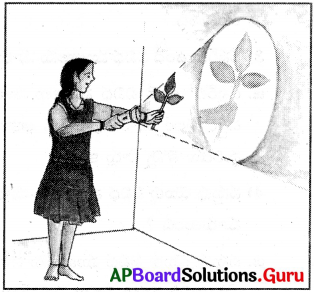
1) మీ గదిలో పత్రం నీడ ఎక్కడ ఏర్పడింది?
జవాబు:
గదిలో పత్రం నీడ గోడ మీద ఏర్పడింది.
2) ఇప్పుడు పత్రం క్రింద నుండి కాంతిని ప్రసరింపచేయండి. పత్రం నీడ ఎక్కడ ఏర్పడింది?
జవాబు:
పత్రం నీడ గది పై కప్పు మీద ఏర్పడింది.
3) ఇదే కృత్యాన్ని ఆరుబయట చేయండి. నీడ ఏర్పడిందా?
జవాబు:
లేదు, నీడ ఏర్పడలేదు.
4) దీనిని బట్టి మీకు ఏమి అర్థమయింది?
జవాబు:
నీడ ఏర్పడాలంటే తెర అవసరమని అర్థమయ్యింది.
కృత్యం – 4
6th Class Science Textbook Page No. 124
ప్రశ్న 4.
ఒకే పరిమాణం, వేరువేరు రంగు కలిగిన 4 బంతులను తీసుకొండి. పటంలో చూపినట్లు ఒక్కొక బంతి నీడను టార్చ్ సహాయంతో గోడపై ఏర్పరుస్తూ, మీ స్నేహితులను ఒక్కొక్కరిని ఆ నీడలు చూసి బంతుల రంగులు కనుక్కోవడానికి ప్రయత్నించమని అడగండి. మీ స్నేహితులకు మీ చేతిలోని బంతి కనబడకూడదు. నీడ మాత్రమే కనపడాలి.

1) మీ స్నేహితులు నీడను చూసి బంతి రంగు కనుక్కోగలిగారా?
జవాబు:
లేదు, వాళ్ళు బంతి రంగును ఊహించలేకపోయారు.
2) నీడను చూసి ఆ నీడను ఏర్పరిచిన వస్తువు రంగు కనుక్కోవడం సాధ్యమవుతుందా? కాదా? ఎందుకు?
జవాబు:
వస్తువు యొక్క నీడను గమనించడం ద్వారా దాని రంగును ఊహించడం సాధ్యంకాదు. ఎందుకంటే వస్తువు రంగు ఏదైనా నల్లటి నీడలను మాత్రమే ఏర్పరుస్తుంది. నీడ అంటే కాంతి లేని ప్రాంతం. అందువల్ల వస్తువు యొక్క రంగుతో సంబంధం లేకుండా నీడ ఏర్పడును. నీడ రంగులేనిది.
కృత్యం – 5
6th Class Science Textbook Page No. 125
ప్రశ్న 5.
ఒక పుస్తకం, పెన్, డస్టర్, బంతి, గుండ్రని పళ్లెం మొదలైన వస్తువులను ఒకదాని తర్వాత ఒకటి సూర్యుని వెలుగులో ఉంచి వాటి నీడల ఆకారాలను పరశీలించండి. వాటి నీడలు ఏర్పరచేటప్పుడు ఆ వస్తువుల వివిధ ముఖాలను సూర్యునికి అభిముఖంగా ఉంచుతూ వాటి నీడల్లో ఏర్పడే మార్పులను గమనించండి. మీ పరిశీలనలతో కింది ప్రశ్నలకు ఆలోచించి సమాధానాలు ఇవ్వండి.
1) బంతి నీడకు, గుండ్రని పళ్లెం నీడకూ ఏమైనా పోలిక ఉందా? ఉంటే ఏమిటది?
జవాబు:
అవును, రెండు నీడలూ గుండ్రని ఆకారంలో ఉంటాయి.
2) పెన్నును సూర్యునికెదురుగా నిలువుగా, అడ్డంగా పట్టుకున్నప్పుడు ఏర్పడే నీడల్లో ఏమైనా తేడా ఉందా?
జవాబు:
పెన్ను అడ్డంగా, ఆపై నిలువుగా పట్టుకున్నప్పుడు పెన్ను నీడ భిన్నంగా ఉంటుంది. పెన్నును నిలువుగా పట్టుకున్నప్పుడు నీడ వస్తువు ఆకారంలో కనిపిస్తుంది. పెన్నును అడ్డంగా తిప్పినప్పుడు నీడ గుండ్రంగా ఉంటుంది.
3) డస్టర్ కు ఉండే వివిధ ముఖాలను సూర్యునికి ఎదురుగా ఉంచినప్పుడు ఏర్పడే నీడలలో ఏం తేడా గమనించారు?
జవాబు:
డస్టర్ లో ఉండే వివిధ ముఖాలు సూర్యునికి ఎదురుగా ఉంచినప్పుడు నీడలలో తేడాలను గమనించవచ్చు. డస్టర్ తలం మారినపుడు నీడ ఆకారం కూడా మారిపోయింది. కొన్ని సార్లు నీడ పొడవుగా కనిపిస్తుంది మరియు కొన్ని సార్లు కాదు.
4) వస్తువు యొక్క వివిధ ముఖాలను సూర్యుని వైపుగా తిప్పుతుంటే ఆ వస్తువుతో ఏర్పడిన నీడ ఆకారం ఎందుకు మారుతుంది?
జవాబు:
వస్తువు యొక్క వివిధ ముఖాలను సూర్యుని వైపు తిప్పుతుంటే దాని తలాలు మారుతూ కాంతిని నిరోధించిన ప్రాంతానికి తగ్గట్టు నీడలు ఏర్పడ్డాయి.
![]()
కృత్యం – 6
6th Class Science Textbook Page No. 126
ప్రశ్న 6.
దీర్ఘచతురస్రాకారపు కార్డ్ బోర్డ్ ముక్కను తీసుకోండి. సూర్యునికాంతిని లేదా టార్చ్ లైట్ ను ఉపయోగించి ఆ కార్డ్ బోర్డ్ ముక్కతో వివిధ ఆకారాల నీడలను ఏర్పరచడానికి ప్రయత్నించండి. తదుపరి ప్రశ్నలకు సమాధానాలివ్వండి.
1) ఆ కార్డ్ బోర్డ్ ముక్కతో చతురస్రాకారపు నీడను ఏర్పరచగలిగారా?
జవాబు:
కాంతి వనరు ముందు దీర్ఘచతురస్రాకార కార్డ్ బోర్డ్ ను కొంచెం వంచినప్పుడు అది చదరపు ఆకారపు నీడను ఏర్పరుస్తుంది.
2) త్రిభుజాకార నీడను ఏర్పరచగలిగారా?
జవాబు:
మనం వస్తువును కాంతి వైపు క్రమంగా తిప్పినప్పుడు చదరపు నీడ త్రిభుజంగా మారుతుంది.
3) వృత్తాకార నీడను ఏర్పరచగలిగారా?
జవాబు:
లేదు. వృత్తాకార నీడను ఏర్పరచలేకపోయాము.
4) ఏ ఇతర ఆకారాల నీడలు ఏర్పరచగలిగారు?
జవాబు:
దీర్ఘచతురస్రాకారం, చదరము, సరళరేఖ, రాంబస్, త్రిభుజం వంటి ఆకారాలను ఏర్పరచగలిగాము.
5) ఒకే వస్తువుకు వివిధ ఆకారాల నీడలు ఎందుకు ఏర్పడుతున్నాయి?
జవాబు:
కాంతి కిరణాలు అనుసరించే సరళరేఖ మార్గం కారణంగా, ఒక వస్తువు యొక్క స్థానాన్ని మార్చి మనం వేర్వేరు ఆకారాలను పొందవచ్చు.
కృత్యం – 7
6th Class Science Textbook Page No. 126
ప్రశ్న 7.
1) పిన్హోల్ కెమెరాకు గుండుసూదితో రెండు రంధ్రాలు ఏర్పరిస్తే ఏం జరుగుతుందో ఊహించండి. తర్వాత కెమెరాకు రెండు రంధ్రాలను ఏర్పరచి కొవ్వొత్తిని చూడండి. మీ పరిశీలన మీ నోటు పుస్తకంలో రాయండి.
2) మీరు ఊహించినది సరయినదేనా? పోల్చుకోండి.
జవాబు:
పిన హోల్ కెమెరాకు రెంండు రంధ్రాలు చేస్తే ఆశ్చర్యంగా రెండు ప్రతిబింబాలు ఏర్పడ్డాయి.’ అంటే రెండు రంధ్రాలు రెండు కటకాల వలె పనిచేశాయి.
కృత్యం – 8
6th Class Science Textbook Page No. 128
ప్రశ్న 8.
భూతద్దం తీసుకొని తెల్లని డ్రాయింగ్ షీట్ తో ఏర్పరచిన తెరపై చెట్టు యొక్క ప్రతిబింబం పడేటట్లు చేయండి.
1) షీట్ తెర మీద ఏర్పడిన ప్రతిబింబంలో మీరు ఏమి గమనిస్తారు?
జవాబు:
తెలుపు డ్రాయింగ్ షీట్ తెరమీద ఏర్పడిన ప్రతిబింబం తలక్రిందులుగా, చిన్నదిగా ఉంది.
2) పిన్పల్ కెమెరా ద్వారా మరియు భూతద్దం ద్వారా ఏర్పడిన ప్రతిబింబాల మధ్య ఏ తేడా ఉంది?
జవాబు:
భూతద్దం ద్వారా ఏర్పడిన ప్రతిబింబం పి ల్ కెమెరాతో ఏర్పడిన దానికంటే స్పష్టంగా ఉందని నేను గమనించాను.
![]()
కృత్యం – 9
6th Class Science Textbook Page No. 129
ప్రశ్న 9.
మీ తరగతి గది తలుపు కిటికీలను మూసి గదిని చీకటి చేయండి. మీ స్నేహితులలో ఒకరిని తన చేతిలో అద్దాన్ని పట్టుకోమనండి. ఒక టార్చ్ లైట్ ముందు భాగాన్ని మందపాటి కాగితం లేదా అట్టతో మూసివేసి, ఆ కాగితానికి సన్నని రంధ్రం చేయండి. టార్చి లైట్ ను వెలిగించి ఆ సన్నని రంధ్రం గుండా వచ్చే కాంతిని మీ స్నేహితుని చేతిలో ఉన్న అద్దంపైన పడేట్లు చేయండి. పటంలో చూపినట్లు ఆ అద్దంపై పడిన కాంతి తిరిగి అద్దం నుండి బయలుదేరి ఆ గదిలోని మరొక స్నేహితునిపై పడేట్లుగా అద్దాన్ని సరిచేసి పట్టుకోమని మీ మొదటి స్నేహితునికి చెప్పండి.
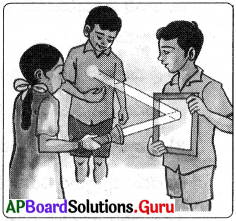
1) పై కృత్యంలో మీరేం పరిశీలించారు?
జవాబు:
ఏదైనా వస్తువుపై కాంతి పడినపుడు, అది తిరిగి వెనుకకు మరలుతుంది. దీనిని పరావర్తనం అంటారు.
2) అద్దాన్ని పట్టుకున్న మీ మొదటి స్నేహితునితో టార్చ్ లైట్ కాంతి. అద్దం మీద పడకుండా ఏదైనా పుస్తకాన్ని అద్దానికి అడ్డుగా ఉంచమని చెప్పండి. ఇప్పుడు టార్చ్ లైట్ ను వెలిగించి కాంతిని పుస్తకంపై పడేట్లు చేయండి. ఆ కాంతి పరావర్తనం చెంది మీ రెండో స్నేహితునిపై పడిందా? లేదా? ఎందువల్ల?
జవాబు:
అద్దం స్థానంలో పుస్తకం ఉంచినప్పుడు నా స్నేహితుడిపై కాంతి పడలేదు. ఎందుకంటే పుస్తకం యొక్క ఉపరితలం అద్దంలా మృదువైనది కాదు. మృదువైన ఉపరితలాలపై పరావర్తనం ప్రభావవంతంగా ఉంటుంది.
3) పుస్తకంపై పడిన కాంతి పరావర్తనం చెందలేదా?
జవాబు:
పుస్తకంపై పడిన కాంతి పరావర్తనం చెందుతుంది. కానీ అది క్రమ రహిత పరావర్తనం. ఎందుకంటే పుస్తక ఉపరితలం అద్దంలా మృదువైనది కాదు.
ప్రాజెక్ట్ పనులు
6th Class Science Textbook Page No. 131
ప్రశ్న 1.
ఒక గాజు దిమ్మెను ఒక చివర పట్టుకుని ఎండలో నిలబడండి. మీ చేతి నీడ, గాజు దిమ్మె నీడలను పరిశీలించండి. ఏం గమనించారో వివరించండి.
జవాబు:
a) గాజు దిమ్మె నీడను ఏర్పరచదని నేను కనుగొన్నాను.
b) నా చేతి నీడను గమనించాను.
c) దీని అర్థం గాజు దిమ్మె పారదర్శక వస్తువు మరియు చేయి అపారదర్శక వస్తువు.
d) అపారదర్శక వస్తువులు మాత్రమే స్పష్టమైన నీడను ఏర్పరుస్తాయని నేను నిర్ధారించుకొన్నాను.
e) మరియు పారదర్శక వస్తువులు నీడలను ఏర్పరచవు.
ప్రశ్న 2.
ఏదైనా అపారదర్శక వస్తువుపై ఒక ప్రత్యేకమైన రంగు గల కాంతిని ప్రసరింపజేస్తే దాని నీడకు రంగు ఉంటుందా? లేదా? ఊహించండి. ప్రయోగం చేసి చూడండి. (పారదర్శక రంగు కాగితాలు (డ్రామాలైట్ల .. కాగితాలు) టార్చ్ ముందు అమర్చి ప్రత్యేకమైన రంగు గల కాంతిని పొందవచ్చు.)
జవాబు:
a) రంగు గల కాంతిలో అపారదర్శక వస్తువులు నీడలను ఏర్పరచుతాయి.
b) కాని వాటి నీడలకు రంగు ఉండదు.
c) ఎందుకంటే నీడ కాంతిని నిరోధించే ప్రదేశం.
d) ఇది కాంతి రంగు ద్వారా ప్రభావితం కాదు.
ప్రశ్న 3.
మామూలు విద్యుత్ బల్ట్, ట్యూబ్ లైట్ లలో ఏది కచ్చితమైన ఆకారం గల నీడలు ఏర్పరుస్తుంది? ప్రయోగం చేసి కనుక్కోండి. కారణం తెలపండి.
జవాబు:
a) ఎలక్ట్రిక్ బల్బ్ మరియు ట్యూబ్ లైట్లలో ఎలక్ట్రిక్ బల్బ్ వలన స్పష్టమైన మరియు కచ్చితమైన ప్రతిబింబము ఏర్పడుతుంది.
b) ఎలక్ట్రిక్ బల్బ్ గుండ్రని ఆకారంలో ఉంటుంది.
c) ఇది ఎక్కువ కాంతిని ఇస్తుంది.
d) మరియు దీని కాంతి తీవ్రంగా ఉంటుంది.
e) విద్యుత్ బల్బ్ లో కిరణాలు ఒక కేంద్ర బిందువు నుండి వస్తాయి. అందుకే విద్యుత్ బల్బ్ కచ్చితమైన మరియు స్పష్టమైన నీడలను ఏర్పరుస్తుంది.
f) కాని ట్యూబ్ లైట్లో కిరణాలు అలా ఉండవు.
g) ఇక్కడ కాంతి జనకం పొడవుగా ఉంటుంది.
h) మరియు కాంతి వేరు వేరు వైపుల నుండి వస్తువులపై పడుతుంది.
i) కాబట్టి నీడ కచ్చితంగా, అంత స్పష్టంగా ఉండదు.
![]()
ప్రశ్న 4.
నీ గదిలో గోడపైన ఒక అద్దం ఉంది. ఆ గదిలో నీ స్నేహితుడు ఒక కుర్చీలో కూర్చుని ఉన్నాడు. గోడపైన ఉన్న అద్దంలో నీవు అతనికి కనిపించడం లేదు. అద్దంలో నీవు నీ స్నేహితునికి కనిపించడానికి నీవు నీ స్థానాన్ని ఎలా మార్చుకుంటావు? వివరించండి.
జవాబు:
a) ఒక చిన్న టెక్నిక్ తో అద్దంలో నా స్నేహితుడికి నేను కనిపించవచ్చు.
b) పరావర్తనం వలన అద్దంలో ప్రతిబింబం ఏర్పడును.
c) పడిన కాంతి అంతే కోణంలో పరావర్తనం చెందును.
d) అందుకే నా స్నేహితుడు నాకు కనిపించినప్పుడు నేను అతనికి కనిపిస్తాను.
e) కాబట్టి నా స్నేహితుడు నాకు కనిపించే వరకు నేను నా స్థలాన్ని సర్దుబాటు చేస్తాను.
f) నా స్నేహితుడు నాకు కనిపించినప్పుడు, నేను కూడా నా స్నేహితుడికి కనిపిస్తాను.
